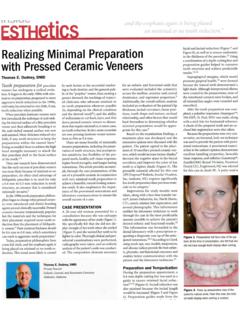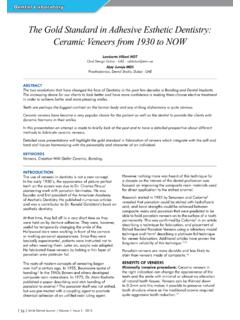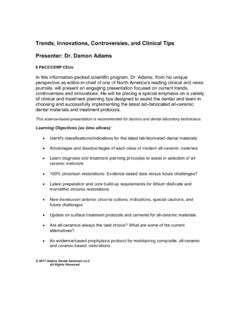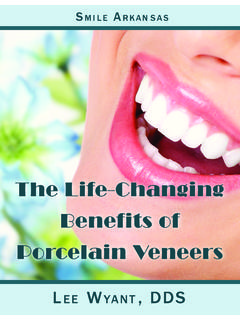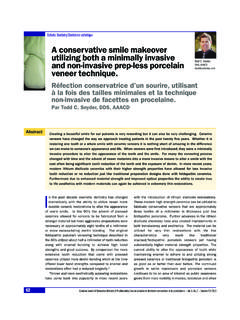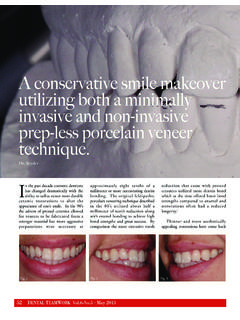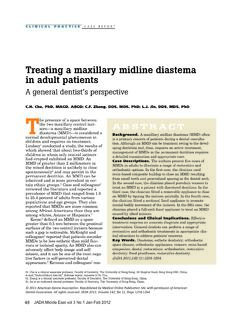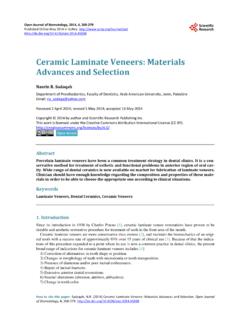Transcription of Guide to All-Ceramic Bonding - naturalikelab.com
1 Guide to All-Ceramic BondingAuthorsJohn M. Powers, Dental Consultants, Inc. (THE DENTAL ADVISOR), Ann Arbor, Michigan, and Professor of Oral Biomaterials, University of Texas School of Dentistry at Houston, Houston, TexasJohn W. Farah, , Dental Consultants, Inc. (THE DENTAL ADVISOR), Ann Arbor, MichiganKathy L. O Keefe, , Private Practice, Houston, TexasBrent Kolb, Private Practice, Dexter, MichiganGytis Udrys, Private Practice, Saline, MichiganDisclosure: The authors (JMP, JWF) have a financial interest in Dental Consultants, Inc., publisher of THE DENTAL ADVISOR, and are also members of ADCAA, (Apex Dental Milling), an Authorized Lava Milling restorations are favorable alternatives to metal- ceramic and all-metal restorations. All-Ceramic restorations have superior esthetics, are biocompatible and are durable.
2 Twenty-five years of experience by THE DENTAL ADVISOR shows that fracture and chipping of All-Ceramic restorations are similar to those of ceramic -metal are two major categories of All-Ceramic materials: silica-based (feldspathic porcelains, leucite-reinforced ceramics, lithium disilicate ceramics) and non-silica-based (zirconia or Y-TZP, alumina). Because of differences in strength and requirements for Bonding or cemen-tation, the selection of cement is important. This article describes characteristics and properties of various types of All-Ceramic materials and associated MATERIALSA variety of All-Ceramic materials are available today. Products include silica-based ceramics (feldspathic porcelains, leucite-rein-forced ceramics, lithium disilicate ceramics) and non-silica-based ceramics (zirconia, alumina) (Table 1). The dentist must choose the optimum All-Ceramic material for particular clinical situations.
3 This section describes the composition, properties and case selec-tion of All-Ceramic to All-Ceramic BondingC O N T E N T S All-Ceramic MATERIALS 2 Feldspathic Porcelains 3 Composition of Feldspathic Porcelains 3 Case Selection of Feldspathic Porcelains 3 Leucite-reinforced Ceramics 3 Composition of Leucite-reinforced Ceramics 3 Case Selection of Leucite-reinforced Ceramics 3 Lithium Disilicate 3 Composition of Lithium Disilicate Ceramics 4 Case Selection of Lithium Disilicate Ceramics 4 Zirconia-based Ceramics 4 Composition of Zirconia-based Ceramics 4 Case Selection of Zirconia-based Ceramics 4 RESIN CEMENTS 5 Composition of Resin Cements 5 Manipulation of Resin Cements 5 Properties of Resin Cements 5 Clinical Tips 6 Bond Strengths of Resin Cements to Tooth Structure 6 PRIMERS FOR ceramic SUBSTRATES 7 Bonding MECHANISMS OF CEMENTS TO CERAMICS 7
4 Bonding to Silica-based Ceramics 7 Pretreatment Technique for Silica-based Ceramics 7 Bonding to Zirconia 7 Pretreatment Techniques for Zirconia-based Ceramics 8 Bond Strength to Zirconia-based Ceramics with Tribochemical Silica Coating 8 Bond Strength to Zirconia-based Ceramics with Air-abrasion and ceramic Primer 8 CLINICAL STUDIES 9 Self-adhesive Resin Cements 9 Esthetic Resin Cements 10 ceramic Primer 10 SELECTION OF CEMENTS FOR All-Ceramic RESTORATIONS 10 When Should Lithium Disilicate and Zirconia-based ceramic Restorations be Bonded? 11 SUMMARY 113A summary of the strength of All-Ceramic materials is shown in the box below:Silica-based Ceramics Flexural StrengthFeldspathic porcelain 65-120 MPaLeucite-reinforced ceramic 120-140 MPaLithium disilicate ceramic 300-400 MPaNon-silica-based CeramicsAlumina 650 MPaZirconia 800-1500 MPaA summary of indications for All-Ceramic materials is shown in the box below.
5 Indications for feldspathic porcelains Highly esthetic veneers or anterior crowns in cases where color masking is not an issueIndications for leucite-reinforced ceramics Esthetic veneers and anterior crowns As a layering porcelain on leucite-reinforced, lithium disilicate, alumina, or zirconia coresIndications for lithium disilicate ceramics Veneers Premolars and molars - inlays, onlays and crowns Three-unit bridges anterior and premolar regionIndications for zirconia-based ceramics Anterior and posterior crowns Bruxers full-contour crowns Anterior and posterior bridges (maximum 14-unit bridges, span depends on product and number of abutments) Endodontically treated teeth Implant abutments Inlay bridges Maryland bridges Block-out of darkened tooth structure or coresFeldspathic PorcelainsFeldspathic porcelain is a silica-based ceramic available in sintered, pressed and milled forms.
6 Examples of feldspathic porcelains are listed in Table of Feldspathic PorcelainsFeldspathic porcelain is composed of leucite (potassium alumino-silicate) and glass. It has low to medium values of flexural strength (65-120 MPa).Case Selection of Feldspathic PorcelainsEsthetics is the number one priority for ceramic restorations and feldspathic porcelain is arguably the most esthetic porcelain, since it has superior translucency. It is technique sensitive and fewer laboratories are offering this service. Due its low strength, it is not recommended for bruxers or in high wear areas and it is rarely used for full CeramicsLeucite-reinforced ceramic is a silica-based ceramic available in sintered, pressed and milled forms. Examples of leucite-reinforced ceramics are listed in Table of Leucite-reinforced CeramicsLeucite-reinforced ceramics contain up to 45% by volume of leucite.
7 Leucite is a reinforcing phase that results in medium values of flexural strength (120-140 MPa) and compressive strength. Leucite crystals can act as crack deflectors and contribute to increased resistance to crack Selection of Leucite-reinforced CeramicsLeucite-reinforced ceramics are recommended when esthetics is the primary objective. These ceramics are less technique sensitive than feldspathic porcelains. They are not recommended for pos-terior crowns because of their low strength; however, they can be used for inlays and DisilicateLithium disilicate ceramic is a silica-based ceramic available in sintered, pressed and milled forms. Examples of lithium disilicate ceramics are listed in Table resin cement - cement based on acrylic or diacrylate resin with adhesive monomers that bond well to metal substrates. Adhesive resin cements may require a sepa-rate primer for Bonding to ceramic and tooth substrates.
8 Esthetic resin cement - tooth-colored or translucent cement based on diacrylate resin that requires a Bonding agent for adhesion to tooth structure and separate primers for Bonding to ceramic resin cement - cement with adhesive components that eliminate the need for separate primers for Bonding to tooth structure and ceramic restoration - ceramic restoration bonded with resin restoration - ceramic restoration that is mechanically retained (luted) on a standard preparation with cement that does not chemically bond to tooth Primer (Silane coupling agent) primer based on silane used with silica-based ceramics (feldspathic porcelain, leucite-reinforced ceramic , lithium disilicate ceramic ). ceramic Primer primer based on acidic adhesive monomers used with alumina- and zirconia-based ceramics. ceramic primers may contain silane and metal of Lithium Disilicate CeramicsLithium disilicate ceramics consist of about 65% by volume of highly interlocking lithium disilicate crystals dispersed in a glassy matrix.
9 These ceramics have high flexural strength (300-400 MPa) and high fracture Selection of Lithium Disilicate CeramicsLithium disilicate restorations combine strength with good esthet-ics. They can be layered with feldspathic porcelain using a cutback technique. Shaded lithium disilicate ingots are available for blocking out dark CeramicsZirconia (zirconium oxide)-based ceramics have become one of the most popular types of All-Ceramic restorations available today. Zirconia-based ceramics utilize CAD/CAM technology for fabrication of copings for crowns, bridges and implant abutments. Zirconia (zirconium oxide, Y-TZP) is milled in the green or pre-sintered state and then sintered, during which the material shrinks about 20%. The sintered zirconia coping has very high flexural strength. After the copings are fabricated, a ceramic veneer com-patible with the properties of the zirconia coping is either pressed , stacked or milled, creating a uniquely strong and esthetic restora-tion.
10 Examples of zirconia-based ceramics are listed in Table of Zirconia-based CeramicsPartially stabilized zirconia, especially yttria-sta-bilized zirconia (Y-TZP), is the most common zirconia-based ceramic in dentistry. Values of flexural strength range from 800 to 1500 MPa. Recently, zirconia-based ceramics with higher translucency have become Selection of Zirconia-based CeramicsZirconia-based crowns are esthetic and can be ideal for restoration of endodontically treated teeth that have become discolored and need an opaque substructure to mask the discolora-tion. Full-contour zirconia restorations provide esthetic options for patients who are heavy bruxers or have other parafunctional habits. The high flexural strength and fracture tough-ness of zirconia are beneficial in these cases, but potential wear of opposing dentition is a concern.
